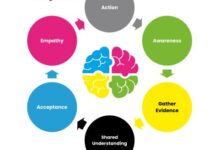Knowing & teaching the reading brain

Our brains are naturally wired to speak; they are not naturally wired to read and write.
We have to teach our brains to be literate brains by consciously teaching in a way that builds a reading network in the brain. We now know all brains learn to read in the same way; however, this doesn’t mean they learn at the same pace.
When learning to read, our brain makes connections in our speech sound system (phonological awareness), our phonics chip (matching sounds to letters), our meaning processing (enabling us to comprehend what we read), and our letterbox (where we store words to our long-term memories). We aren’t born with the white matter to connect these areas. These have to be taught and activated for word reading (and spelling) to take place.
With a dyslexic brain, it is harder to get these processing systems to make these connections. This is most often (but not always) associated with difficulties with phonological awareness. Understanding ‘why’ and having knowledge and tools that align with ‘how’ we learn to read is vital to be able to put in place the appropriate evidence-based action, strategies, and support.
This article appeared in our Term 1 print issue, read it online here: https://issuu.com/multimediaau/docs/snnz56
We can support our dyslexic learners by ensuring they have the necessary foundation literacy skills to manage the demands of the curriculum. We can support them by understanding their pace or processing speed and cognitive profile. We can support them by going as fast as we can but as slow as we must and allowing lots of opportunities for repetition.
Teaching spelling systematically is a must in the primary years. A direct and explicit teaching approach to spelling is fundamental to the development of the dyslexic brain. Let’s not give words in our classrooms (such as unrelated words on spelling lists). Let’s teach spelling in a systematic and cumulative way; one which builds on concepts previously learned by following a comprehensive scope (content) and sequence (teaching order) that is thorough, increases in complexity and teaches syllable types and syllable division strategies as well as spelling
rules.
Given the English language is only four percent irregular, knowing how it works is doable. Diagnostic assessment is crucial to identify teaching and learning needs in relation to the scope and sequence, to be able to adjust pacing in lessons and to measure retention of what has been previously taught.
It is our role as educators to support all ākonga. But how do we teach in a way that caters for the range of literacy levels that occur in a classroom?
In the Dyslexia Kete, the Ministry of Education has identified Structured Literacy as the most effective method for teaching dyslexic ākonga. But this is also an evidence-based approach that is effective and can be implemented with accommodations for all learners. For example, if we were to teach the Silent ‘e’ syllable type in a whole-class approach, the fundamentals of the concept are the same. Additional complexities can be layered, or more repetition and explicit teaching may be required, depending on the ability of the student. The approach can be scaffolded to cater for all learners.
Within the classroom, every learner is following the same scope and sequence. They feel supported, can learn at their own pace, and apply the knowledge they have learned by using suitable resources such as decodable texts (to a certain point in the scope and sequence) and supporting material that is tailored to their learning pace. These can help them to transfer skills, sounds, and letters that have been taught in isolation, to word and sentence level, then taken to texts to assist the development of their reading fluency.
If we can strengthen our teaching approach and be more conscious in the explicit teaching of the reading brain, we can meet the needs of all and remove barriers so our learners can feel safe to engage, feel more confident and supported with their learning, and have the opportunity to flourish.









